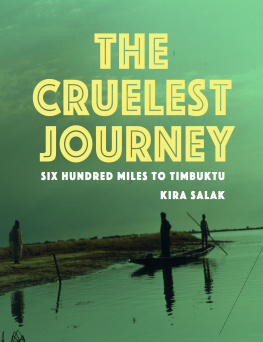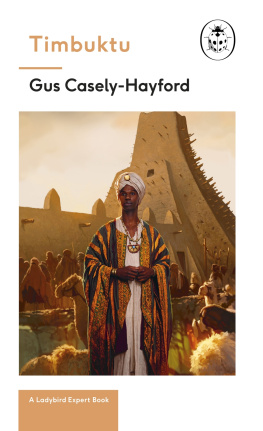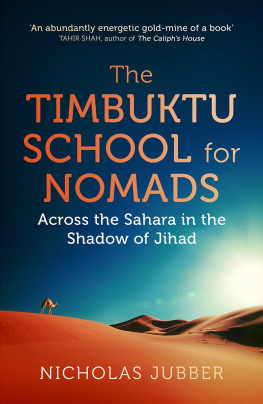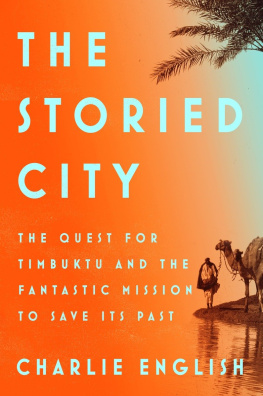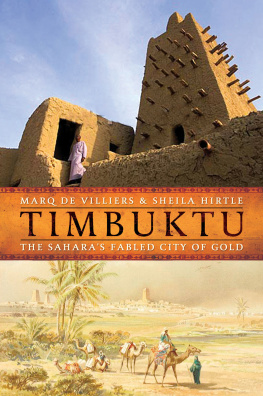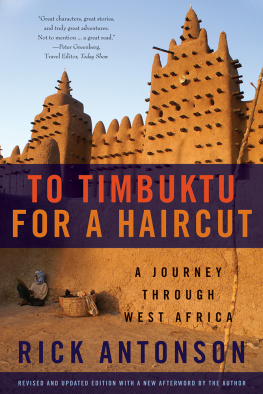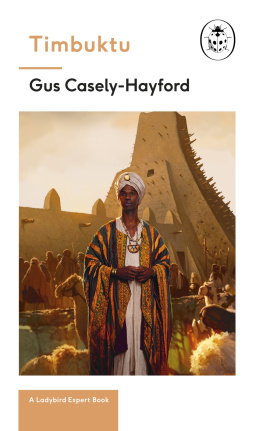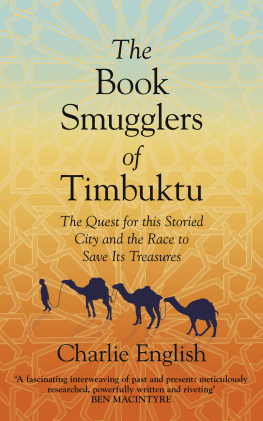THE RACE FOR

TIMBUKTU
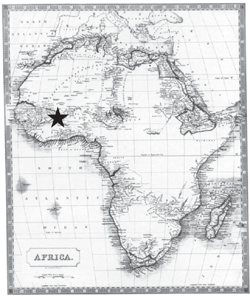
In Search of Africas City of Gold
FRANK T. KRYZA


IN MEMORY OF MY FATHER
E. G REGORY K RYZA
(19221998)
F OREIGN S ERVICE O FFICER
(19501980)
CONTENTS

I N WRITING THIS BOOK , I have often quoted firsthand sources dating from the early nineteenth century. In such quotations, the original and erratic spelling, punctuation, grammar, and typographical conventions (for example, the liberal use of uppercase initial letters for many words) have been retained, except in longer passages where I found them distracting. Similarly, abbreviations common in the era (RNRoyal Navy; HMBHis Majestys Brig; RACRoyal Africa Corps), but now unfamiliar, have been spelled out to avoid confusion.
Some proper names and names of vessels have variant spellings depending on the primary source consulted. I have employed the most commonly used form where this can be ascertained. When it was not possible to determine the most common form, I selected one and have been consistent in its use throughout the narrative.
Geographical places are referred to by their names at the time, with the modern equivalent, if different, in parentheses at first mention. My source for the modern spelling of geographical names is Websters New Geographical Dictionary.
Mileage figures are given in statute miles5,280 feet per mile. Temperatures cited are in degrees Fahrenheit. One pound sterling comprised twenty shillings; a shilling comprised twelve pence. A guinea equaled a pound plus a shilling. A sovereign was a gold coin worth a pound. When dollars are referred to, they are Spanish dollars unless otherwise stated.
Though it is difficult to attach a modern value to these figures, cost-of-living indicators for the era provide a basis for comparison. For example, in 1825, 500 pounds a year was a comfortable annual wage for a mid-level government bureaucrat living in London. The salary of 950 pounds a year paid to His Britannic Majestys consul general to the Regency of Tripolitania, spent in Tripoli (where living costs were far lower than in London), would have accommodated a princely lifestyle.
Finally, a word about the transliteration of Arabic words. Writing Arabic words in English presents a number of difficulties, even for those familiar with both languages. In 1926, when T. E. Lawrence sent his 130,000-word manuscript of Revolt in the Desert to be typeset, a sharp-eyed proofreader noted that it was full of inconsistencies in the spelling of Arabic words. Among other things, the reader pointed out that Jeddah (the city) alternated with Jidda throughout the book, while a man whose name began as Sherif Abd el Mayin later became el Main, el Mayein, el Muein, el Mayin, and le Muyein. Lawrence refused to change the spellings. Arabic words, he replied, wont go into English exactly, for their consonants are not the same as ours, and their vowels, like ours, vary from district to district. So it is.
In early drafts, I found jabal, jebel, gebel, gibel, and gabal (meaning mountain) appearing randomly throughout my pages, while coffle, caffle, goffle, kaffila, and kafila (meaning caravan) also made seemingly spontaneous appearances. My first inclination was to solve this difficulty by omitting all Arabic words from the text, excluding proper names, but I soon discovered that this robbed the narrative of some of its flavor. I therefore restored some of the excluded words, settling on a single spelling throughout, trying to pick the transliteration that best captured, phonetically, the original sound as spoken by a native speaker from the southern Mediterranean. When its meaning was not obvious in the context of the sentence, I have provided a definition of the word at first mention.

I N THE FIRST TWO DECADES of the nineteenth century, no place burned more brightly in the imagination of European geographersand fortune huntersthan the lost city of Timbuktu. For five centuries, legends about its wealth and culture had circulated from Venice to London. Like El Dorado in the Americas, Timbuktu assumed the quality of a mythic dream hidden in the unseen sprawl of Africa, a city paved with gold that lay just beyond the next range of mountains or a bit deeper in the unexplored African jungles.
Timbuktu, like El Dorado, held the explicit promise of riches and fame. No European explorer had been there and returned since the Middle Ages. Whoever got there first was guaranteed worldwide renown, but the journey would be bitter and hardand could be fatal.
El Dorado, it turned out, was a city never found for the compelling reason that it did not exist. But Timbuktu was a real place. It is easily located on any modern map of Mali, near the center of the country, on the southern edge of the Sahara, about eight miles north of the river Niger.
From that moment in the 1780s when an armchair-bound coterie of British aristocrats decided they would find it, along with the termination of the Niger, a determined search for Timbuktu was to occupy European explorers for the next fifty years.
Beyond its attraction as a center of great wealth, no city was more worthy of discovery for geographical and scientific reasons. Arabic texts documented that merchants from Tripoli to Morocco had gathered at Timbuktu since the late thirteenth or early fourteenth centuries, when it was incorporated into the great Malian Empire, to buy gold and slaves in exchange for prized European manufactured goods, cloth, horses, and the mined salt of the desert. Scholars reputedly made up as much as a quarter of the citys huge permanent population of 100,000, many of whom had studied in Cairo and other seats of Islamic culture, and who had themselves attracted students from an even wider ambit, stretching as far away as Mecca and Baghdad and deep into the northern reaches of sub-Saharan Africa, where Islam had made inroads unimagined in Europe.
The Sahara was known mainly as a vast swath of inhospitable desert, but there was evidence in Moroccan archives that trade had been conducted across the region since early times. Evidence from the pre-Islamic era was sketchy, but it seemed likely that gold, animal skins, ivory, gemstones, perfumes, and black slaves from the Sudan states (in the terminology of the age, here, as elsewhere in this book, Sudan or Soudan refers to all those states southwest of the Sahara, not the modern nation of Sudan) were exchanged for the manufactures and trinkets of the Phoenician, Roman, and Byzantine worlds. The Muslim Arab conquest of North Africa from the seventh century onward saw the establishment of a regular trans-Saharan trade in black slaves.
Having taken their empire, the Arabs sealed it off. Foreigners who dared Soon the integrated web of lands under Arab sway became a vast trading commonwealth, the principal objects of commerce at Timbuktu being salt, gold, and slaves.
Next page

